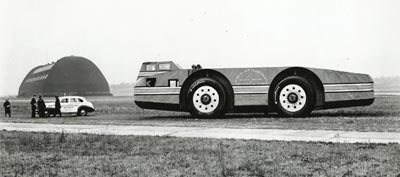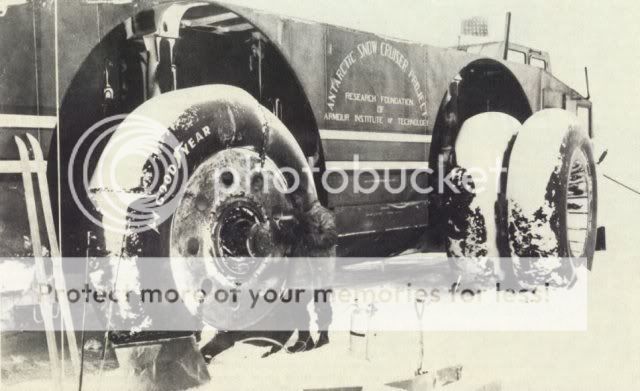|
FF.Com.Au Hardcore
Join Date: Nov 2009
Posts: 3,876
|
 The 1939 Snow Cruiser
The 1939 Snow Cruiser
|
|
Found this in some internet searching, what a beast! Reminds me a bit of the Spruce Goose...
 http://www.thule.org/snowcruiser.html
http://www.thule.org/snowcruiser.html
Quote:
The Antarctic Snow Cruiser
Early one October morning in 1939, an improbable vehicle lumbered out of Chicago on the first leg of a long and eventful trip to Boston. It looked like something from the mind of H. G. Wells, with its high, slanted turret and red and silver paint. It was so huge that the roads it traveled had to be closed to other traffic.
The Antarctic Snow Cruiser was the inspiration of Thomas C. Poulter, a physicist and explorer who had experienced the difficulties of polar travel firsthand during the second Byrd expedition in 1934. As second-in-command, Poulter had used snow tractors in his heroic rescue of Rear Adm. Richard E. Byrd from the advance base hut where he lay ill with carbon monoxide poisoning.
After covering hundreds of miles in the tractors under emergency conditions, Poulter knew how cramped and impractical they were for long hauls.
After that expedition Poulter joined the Research Foundation of Armour Institute of Technology, in Chicago. He convinced his new colleagues that what the country needed was the ultimate polar exploration vehicle, something to solve the problem of moving outposts in the interior of Antarctica. Other countries were claiming territory there; the United States needed to use its superior technology to seize the advantage. Who knew what mineral wealth might lie beneath the ice?
When the United States announced plans for a third Antarctic expedition in 1939, Poulter rushed to Washington and sold officials on the idea of the cruiser, which would be built at private expense and lent to the government. At that point Poulter had less than six months to complete a gigantic machine loaded with novel design features that would have to function in the harshest environment on earth.
The specifications for the vehicle were daunting. It would have a range of five thousand miles and room for a crew of five and food and supplies for a year. The crew would include an airplane pilot, because the cruiser would carry a plane on its back for photography and mapping. Finally, it would have to be able to cross small crevasses; otherwise it would never make it through the first hundred miles.
Getting it built on time might have thwarted a lesser man, but Poulter was a swashbuckler among scientists. He and his colleagues capitalized on the popular excitement about Antarctic exploration and persuaded more than seventy American companies to donate labor, materials, and equipment. Construction took place at a fever pitch in the Pullman shops in Chicago. It began on August 8; in November the expedition's ships would sail from Boston.
The completed vehicle was 55 feet 8 inches long, 19 feet 10.5 inches wide, and 16 feet high. Fully loaded it weighed 75,000 pounds. Power was supplied by diesel engines, which drove generators that ran electric motors in the wheel hubs. In addition to its control cabin, the cruiser had a machine shop, a combination darkroom and kitchen, and living quarters that rivaled those in many a pre-war bungalow. In the rear was storage space for fuel, food, and tires. The antifreeze that cooled the engines was circulated through radiators to heat the living quarters.
Poulter's solution to the crevasse problem was his most daring innovation. The four immense wheels of the cruiser were set close to the center of its body, producing an overhang in front and back of more than seventeen feet. The wheels could be retracted vertically until they were flush with the cruiser's body. Upon reaching a crevasse, Poulter proposed to retract the front wheels and push the front half of the cruiser across until it rested on the other side of the chasm. Then he would retract the back wheels, extend the front ones, and pull the cruiser the rest of the way across.
As soon as it was built, the cruiser started its cross-country odyssey, which turned into a melange of mishaps and hoopla. It made its ponderous way, accompanied by a retinue of police and press vehicles, attracting larger and larger crowds and increasingly breathless newspaper articles. In Pavilion, New York, Poulter stopped to allow a group of blind children to touch the machine.
At Springfield, Massachusetts, crippled children in hospital beds were bundled against the cold and carried into the open air to watch it pass.
Photocard by Ray D. Gottfried, provided by Robert Nighswander
Public gawking reached its climax in Framingham, Massachusetts, near Boston. Sightseers jammed the town with more than seventy thousand cars. Finally, no doubt with great relief, Poulter drove the cruiser onto the ship North Star at the Boston Army Wharf. On November 15 the North Star put out to sea with its expedition team, including Admiral Byrd and Poulter, both of whom would leave the expedition shortly after its arrival and return to the United States.
Once the ship reached Antarctica's Ross Ice Shelf in early January 1940, the celebrated cruiser rapidly lost its glamour. It almost crashed through the ramp when Poulter drove it off the ship. Further disappointment followed when Poulter and F. Alton Wade tried to move it through the snow.
It quickly became apparent that the designers' assumptions about traction had been erroneous. The huge tires spun helplessly much of the time, sinking as much as three feet into the snow. Furthermore, the big vehicle was seriously under powered. The motors overheated after it had gone only a few hundred yards.
On January 24, 1940, Poulter departed, leaving Wade in charge of a floundering leviathan. The newspapers were losing enthusiasm. One called the cruiser "a complete flop"; another christened it ''the dinosaur on wheels." Wade and his crew tried several times to move it, with little success.
After several months of frustration, as the Antarctic winter approached, the crew members gave up on exploration and covered the cruiser with snow and timbers. It made a fine bivouac. The cruiser could be heated so effectively that the crew slept with only the lightest of covers. Scientific members of the expedition conducted a limited program of seismology experiments, cosmic-ray measurements, and ice borings, while Wade made entries in his journal.
Overshadowing everything was the tedium of the long polar winter and the news about war in Europe. As America braced itself for possible entry into World War II, the U.S. Antarctic Service lost its funding. It became clear that the expedition would never finish its planned multi-year tour.
Poulter talked from stateside about modifications that might make the cruiser operational, but Wade began to sense that the machine would never work. He wrote in his diary, "I am rather dejected tonight when I think of the many long hours of planning, the days of hurried construction, the hopes, ambitions, etc. of Tom Poulter that are gone with the wind. So much had been expected of the cruiser and the pity of it all is that it just misses being the perfect machine for the work." The cruiser was abandoned when the expedition left Antarctica in early 1941.
In the turmoil of war the snow cruiser was quickly forgotten, and afterward it got lost in the deluge of postwar technology. A nation that had read of the blitzkrieg and Hiroshima, and seen Sherman tanks and B-29s, would no longer crowd roadsides to watch a snow cruiser roll by.
Thomas Poulter emerged unharmed from the episode. In 1948 he joined the Stanford Research Institute in Menlo Park, California, where he remained until his death in 1978. In that long period he ranged widely in his research, from the dynamic phenomena of explosives and ballistics to the communication of marine animals.
The cruiser seems not to have influenced polar transportation in any way -- for years the most effective snow vehicles continued to be crawlers with treads -- but it did serve one useful purpose.
In 1958 an International Geophysical Year team located the cruiser by digging with a bulldozer where a bamboo pole protruded atop many feet of snow. Reaching the spot where its wheels rested in the snow, glaciologists were able to measure accurately the snowfall since its abandonment. Inside the cruiser they found a litter of old magazines, papers, and cigarettes.
What thereafter became of the vehicle has remained the subject of conjecture. The approximate location at which it was abandoned is known, but the cruiser is nowhere to be found. One theory is that it broke off on an ice floe, floated out to sea, and sank. Another, more intriguing notion is that the Soviets took it. Of course, they would have had the same difficulties moving it that the Americans did. Still, it's engaging to think that Tom Poulter's snow cruiser might have slumbered the years away somewhere in Siberia.
|


|















